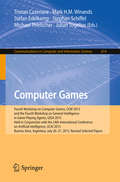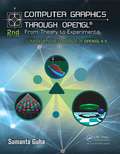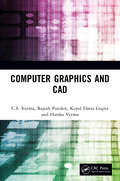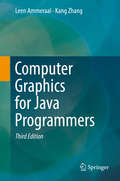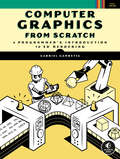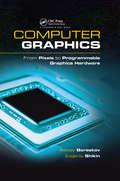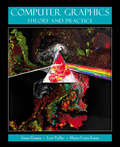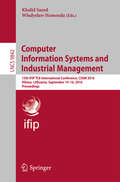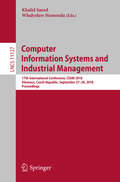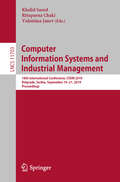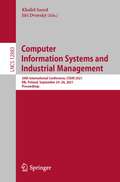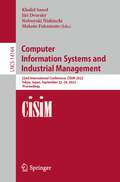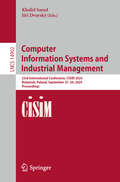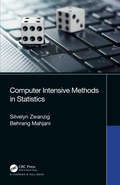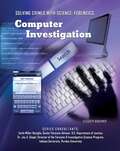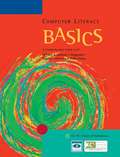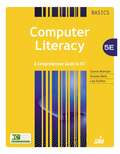- Table View
- List View
Computer Games: 7th Workshop, CGW 2018, Held in Conjunction with the 27th International Conference on Artificial Intelligence, IJCAI 2018, Stockholm, Sweden, July 13, 2018, Revised Selected Papers (Communications in Computer and Information Science #1017)
by Tristan Cazenave Abdallah Saffidine Nathan SturtevantThis book constitutes revised selected papers from the 7th Workshop on Computer Games, CGW 2018, held in conjunction with the 27th International Conference on Artificial Intelligence, IJCAI 2018 in Stockholm, Sweden, in July 2018.The 8 full papers presented in this volume were carefully reviewed and selected from 15 submissions. They cover a wide range of topics related to video games; general game playing.- machine learning and Monte Carlo tree search.
Computer Games: Fourth Workshop on Computer Games, CGW 2015, and the Fourth Workshop on General Intelligence in Game-Playing Agents, GIGA 2015, Held in Conjunction with the 24th International Conference on Artificial Intelligence, IJCAI 2015, Buenos Aires, Argentina, July 26-27, 2015, Revised Selected Papers (Communications in Computer and Information Science #614)
by Tristan Cazenave Mark H.M. Winands Stefan Edelkamp Stephan Schiffel Michael Thielscher Julian TogeliusThis book constitutes the refereed proceedings of the Fourth Computer Games Workshop, CGW 2015, and the Fourth Workshop on General Intelligence in Game-Playing Agents, GIGA 2015, held in conjunction with the 24th International Conference on Artificial Intelligence, IJCAI 2015, Buenos Aires, Argentina, in July 2015. The 12 revised full papers presented were carefully reviewed and selected from 27 submissions. The papers address all aspects of artificial intelligence and computer game playing. They discuss topics such as Monte-Carlo methods; heuristic search; board games; card games; video games; perfect and imperfect information games; puzzles and single player games; multi-player games; combinatorial game theory; applications; computational creativity; computational game theory; evaluation and analysis; game design; knowledge representation; machine learning; multi-agent systems; opponent modeling; planning; reasoning; search.
Computer Games: Workshop on Computer Games, CGW 2013, Held in Conjunction with the 23rd International Conference on Artificial Intelligence, IJCAI 2013, Beijing, China, August 3, 2013, Revised Selected Papers (Communications in Computer and Information Science #408)
by Tristan Cazenave Mark H.M. Winands Hiroyuki IidaThis book constitutes the refereed proceedings of the Computer Games Workshop, CGW 2013, held in Beijing, China, in August 2013, in conjunction with the Twenty-third International Conference on Artificial Intelligence, IJCAI 2013. The 9 revised full papers presented were carefully reviewed and selected from 15 submissions. The papers cover a wide range of topics related to computer games. They discuss six games that are played by humans in practice: Chess, Domineering, Chinese Checkers, Go, Goofspiel, and Tzaar. Moreover, there are papers about the Sliding Tile Puzzle, an application, namely, Cooperative Path-Finding Problems, and on general game playing.
Computer Graphics Through OpenGL: From Theory to Experiments
by Sumanta GuhaFrom geometric primitives to animation to 3D modeling to lighting, shading, and texturing, Computer Graphics Through OpenGL: From Theory to Experiments, Second Edition presents a comprehensive introduction to computer graphics that uses an active learning style to teach key concepts. Equally emphasizing theory and practice, the book provides an und
Computer Graphics Through OpenGL®: From Theory to Experiments
by Sumanta GuhaCOMPREHENSIVE COVERAGE OF SHADERS AND THE PROGRAMMABLE PIPELINE <P><P> From geometric primitives to animation to 3D modeling to lighting, shading and texturing, Computer Graphics Through OpenGL®: From Theory to Experiments is a comprehensive introduction to computer graphics which uses an active learning style to teach key concepts. Equally emphasizing theory and practice, the book provides an understanding not only of the principles of 3D computer graphics, but also the use of the OpenGL® Application Programming Interface (API) to code 3D scenes and animation, including games and movies. The undergraduate core of the book takes the student from zero knowledge of computer graphics to a mastery of the fundamental concepts with the ability to code applications using fourth-generation OpenGL®. The remaining chapters explore more advanced topics, including the structure of curves and surfaces, applications of projective spaces and transformations and the implementation of graphics pipelines. This book can be used for introductory undergraduate computer graphics courses over one to two semesters. The careful exposition style attempting to explain each concept in the simplest terms possible should appeal to the self-study student as well. <P><P> Features <br>• Covers the foundations of 3D computer graphics, including animation, visual techniques and 3D modeling• Comprehensive coverage of OpenGL® 4.x, including the GLSL and vertex, fragment, tessellation and geometry shaders• Includes 180 programs with 270 experiments based on them• Contains 750 exercises, 110 worked examples, and 700 four-color illustrations• Requires no previous knowledge of computer graphics• Balances theory with programming practice using a hands-on interactive approach to explain the underlying concepts
Computer Graphics and CAD
by C.S. Verma Rajesh Purohit Koyel Datta Gupta Harsha VermaThis book discusses the fundamental concepts shaping modern design and visualization definition through Computer Graphics and the intricacies of CAD modelling practices.From 3D object representation to surface modelling and solid techniques, subsequent chapters offer a comprehensive exploration of advanced topics essential for geometric modelling. With a focus on industry applications and practical examples, readers acquire the skills needed to navigate the complexities of animation systems and finite element analysis, ensuring a holistic understanding of CAD and Computer Graphics. Whether you're a novice or seasoned professional, this guide provides a rich blend of theory and practice, accompanied by a wealth of solved and unsolved problems for hands-on learning.Print edition not for sale in South Asia (India, Sri Lanka, Nepal, Bangladesh, Pakistan or Bhutan)
Computer Graphics for Java Programmers
by Leen Ammeraal Kang ZhangThis third edition covers fundamental concepts in creating and manipulating 2D and 3D graphical objects, including topics from classic graphics algorithms to color and shading models. It maintains the style of the two previous editions, teaching each graphics topic in a sequence of concepts, mathematics, algorithms, optimization techniques, and Java coding. Completely revised and updated according to years of classroom teaching, the third edition of this highly popular textbook contains a large number of ready-to-run Java programs and an algorithm animation and demonstration open-source software also in Java. It includes exercises and examples making it ideal for classroom use or self-study, and provides a perfect foundation for programming computer graphics using Java. Undergraduate and graduate students majoring specifically in computer science, computer engineering, electronic engineering, information systems, and related disciplines will use this textbook for their courses. Professionals and industrial practitioners who wish to learn and explore basic computer graphics techniques will also find this book a valuable resource.
Computer Graphics from Scratch: A Programmer's Introduction to 3D Rendering
by Gabriel GambettaComputer Graphics from Scratch demystifies the algorithms used in modern graphics software and guides beginners through building photorealistic 3D renders.Computer graphics programming books are often math-heavy and intimidating for newcomers. Not this one. Computer Graphics from Scratch takes a simpler approach by keeping the math to a minimum and focusing on only one aspect of computer graphics, 3D rendering. You&’ll build two complete, fully functional renderers: a raytracer, which simulates rays of light as they bounce off objects, and a rasterizer, which converts 3D models into 2D pixels. As you progress you&’ll learn how to create realistic reflections and shadows, and how to render a scene from any point of view. Pseudocode examples throughout make it easy to write your renderers in any language, and links to live JavaScript demos of each algorithm invite you to explore further on your own.Learn how to:Use perspective projection to draw 3D objects on a 2D planeSimulate the way rays of light interact with surfacesAdd mirror-like reflections and cast shadows to objectsRender a scene from any camera position using clipping planesUse flat, Gouraud, and Phong shading to mimic real surface lightingPaint texture details onto basic shapes to create realistic-looking objects Whether you&’re an aspiring graphics engineer or a novice programmer curious about how graphics algorithms work, Gabriel Gambetta&’s simple, clear explanations will quickly put computer graphics concepts and rendering techniques within your reach. All you need is basic coding knowledge and high school math. Computer Graphics from Scratch will cover the rest.
Computer Graphics: From Pixels to Programmable Graphics Hardware (Chapman And Hall/crc Computer Graphics, Geometric Modeling, And Animation Ser. #3)
by Alexey Boreskov Evgeniy ShikinComplete Coverage of the Current Practice of Computer GraphicsComputer Graphics: From Pixels to Programmable Graphics Hardware explores all major areas of modern computer graphics, starting from basic mathematics and algorithms and concluding with OpenGL and real-time graphics. It gives students a firm foundation in today's high-performance graphic
Computer Graphics: Theory and Practice
by Jonas Gomes Luiz Velho Mario Costa SousaComputer Graphics: Theory and Practice provides a complete and integrated introduction to this area. The book only requires basic knowledge of calculus and linear algebra, making it an accessible introductory text for students. It focuses on conceptual aspects of computer graphics, covering fundamental mathematical theories and models and the inher
Computer Hacking: Eine Einführung zur Verbesserung der Computersicherheit in komplexen IT-Infrastrukturen
by Udo KebschullTechnische Maßnahmen, die es Cyberangreifern schwer machen, dienen zur Abschreckung, weil Hacker immer nur so hoch springen, wie sie müssen. Bei komplexen und vor allem sicherheitsrelevanten IT-Infrastrukturen reichen diese technischen Maßnahmen allein jedoch oft nicht aus.Dieses Lehrbuch betrachtet alle Aspekte der IT-Sicherheit und effektive Maßnahmen, um Angriffe zu detektieren und sich erfolgreich dagegen zu wehren. Es behandelt allgemeine Angriffsmechanismen und Angriffsszenarien, die von Angreifern angewendet werden. Dabei soll klar werden, dass es nicht ausreichend ist, Firewall-Regeln sauber zu konfigurieren oder die aktuellsten Patches einzuspielen. Vielmehr muss ein ganzheitlicher Ansatz gewählt werden, der Nutzende einschließt (Awareness) und funktionierende Prozesse für den Fall eines konkreten Angriffs etabliert. Das Buch zeigt, wo die Schwachstellen liegen, wie man sie schließt, wie man Angriffe erkennt und wie man sie erfolgreich abwehrt.
Computer Information Systems and Industrial Management: 15th IFIP TC8 International Conference, CISIM 2016, Vilnius, Lithuania, September 14-16, 2016, Proceedings (Lecture Notes in Computer Science #9842)
by Khalid Saeed Władysław HomendaThis book constitutes the proceedings of the 15th IFIP TC8 International Conference on Computer Information Systems and Industrial Management, CISIM 2016, held in Vilnius, Lithuania, in September 2016. The 63 regular papers presented together with 1 inivted paper and 5 keynotes in this volume were carefully reviewed and selected from about 89 submissions. The main topics covered are rough set methods for big data analytics; images, visualization, classification; optimization, tuning; scheduling in manufacturing and other applications; algorithms; decisions; intelligent distributed systems; and biometrics, identification, security.
Computer Information Systems and Industrial Management: 17th International Conference, CISIM 2018, Olomouc, Czech Republic, September 27-29, 2018, Proceedings (Lecture Notes in Computer Science #11127)
by Khalid Saeed Władysław HomendaThis book constitutes the proceedings of the 17th International Conference on Computer Information Systems and Industrial Management Applications, CISIM 2018, held in Olomouc, Czech Republic, in September 2018. The 42 full papers presented together with 4 keynotes were carefully reviewed and selected from 69 submissions. The main topics covered by the chapters in this book are biometrics, security systems, multimedia, classification and clustering, and industrial management. Besides these, the reader will find interesting papers on computer information systems as applied to wireless networks, computer graphics, and intelligent systems. The papers are organized in the following topical sections: biometrics and pattern recognition applications; computer information systems; industrial management and other applications; machine learning and high performance computing; modelling and optimization; and various aspects of computer security.
Computer Information Systems and Industrial Management: 18th International Conference, CISIM 2019, Belgrade, Serbia, September 19–21, 2019, Proceedings (Lecture Notes in Computer Science #11703)
by Khalid Saeed Rituparna Chaki Valentina JanevThis book constitutes the proceedings of the 18th International Conference on Computer Information Systems and Industrial Management Applications, CISIM 2019, held in Belgrade, Serbia, in September 2019. The 43 full papers presented together with 3 abstracts of keynotes were carefully reviewed and selected from 70 submissions. The main topics covered by the chapters in this book are biometrics, security systems, multimedia, classification and clustering, industrial management. Besides these, the reader will find interesting papers on computer information systems as applied to wireless networks, computer graphics, and intelligent systems. The papers are organized in the following topical sections: biometrics and pattern recognition applications; computer information systems; industrial management and other applications; machine learning and high performance computing; modelling and optimization; various aspects of computer security.
Computer Information Systems and Industrial Management: 19th International Conference, CISIM 2020, Bialystok, Poland, October 16–18, 2020, Proceedings (Lecture Notes in Computer Science #12133)
by Khalid Saeed Jiří DvorskýThis book constitutes the proceedings of the 19th International Conference on Computer Information Systems and Industrial Management Applications, CISIM 2020, held in Bialystok, Poland, in October 2020. Due to the COVID-19 pandemic the conference has been postponed to October 2020. The 40 full papers presented together with 5 abstracts of keynotes were carefully reviewed and selected from 62 submissions. The main topics covered by the chapters in this book are biometrics, security systems, multimedia, classification and clustering, industrial management. Besides these, the reader will find interesting papers on computer information systems as applied to wireless networks, computer graphics, and intelligent systems. The papers are organized in the following topical sections: biometrics and pattern recognition applications; computer information systems and security; industrial management and other applications; machine learning and high performance computing; modelling and optimization.
Computer Information Systems and Industrial Management: 20th International Conference, CISIM 2021, Ełk, Poland, September 24–26, 2021, Proceedings (Lecture Notes in Computer Science #12883)
by Khalid Saeed Jiří DvorskýThis book constitutes the proceedings of the 20th International Conference on Computer Information Systems and Industrial Management Applications, CISIM 2021, held in Ełk, Poland, September 24–26, 2021. The 38 papers presented together with 1 invited speech and 3 abstracts of keynotes were carefully reviewed and selected from 69 submissions. The main topics covered by the chapters in this book are mobile and pervasive computing, machine learning, high performance computing, image processing, industrial management. Additionally, the reader will find interesting papers on computer information systems, biometrics, security systems, and sensor network service. The contributions are organized in the following topical sections: biometrics and pattern recognition applications; computer information systems and security; industrial management and other applications; machine learning and artificial neural networks; modelling and optimization, and others.Chapter 24 "A first step towards automated species recognition from camera trap images of mammals using AI in a European temperate forest" is published open access under a CC BY license (Creative Commons Attribution 4.0 International License).
Computer Information Systems and Industrial Management: 22nd International Conference, CISIM 2023, Tokyo, Japan, September 22–24, 2023, Proceedings (Lecture Notes in Computer Science #14164)
by Khalid Saeed Jiří Dvorský Nobuyuki Nishiuchi Makoto FukumotoThis book constitutes the proceedings of the 22nd International Conference on Computer Information Systems and Industrial Management, CISIM 2023, held in Tokio, Japan, during September 22-24, 2023. The 36 papers presented in this book were carefully reviewed and selected from 77 submissions. They were organized in topical sections as follows: biometrics and pattern recognition applications; computer information systems and security; industrial management and other applications; machine learning and artificial neural networks; modelling and optimization; wellbeing and affective engineering; and machine learning using biometric data and kansei data.
Computer Information Systems and Industrial Management: 23rd International Conference, CISIM 2024, Bialystok, Poland, September 27–29, 2024, Proceedings (Lecture Notes in Computer Science #14902)
by Khalid Saeed Jiří DvorskýThis book constitutes the proceedings of the 23rd International Conference on Computer Information Systems and Industrial Management, CISIM 2024, held in Bialystok, Poland, during September 27-29, 2024. The 31 full papers presented were carefully reviewed and selected from 47 submissions. These papers focus on biometrics and pattern recognition applications; computer information systems and security; industrial management and other applications; machine learning and artificial neural networks; modelling and optimization.
Computer Information Systems and Industrial Management: 24th International Conference, CISIM 2025, Fukuoka, Japan, September 11–13, 2025, Proceedings (Lecture Notes in Computer Science #15927)
by Khalid Saeed Jiří Dvorský Nobuyuki Nishiuchi Makoto FukumotoThis LNCS volume 15927 constitutes the proceedings of the 24th International Conference on Computer Information Systems and Industrial Management, CISIM 2025, in Fukuoka, Japan, held during September 11-13, 2025. The 33 full papers presented were carefully reviewed and selected from 69 submissions. These papers focus on Biometrics and Pattern Recognition Applications; Computer Information Systems and Security; Industrial Management and other Applications; Machine Learning and Artificial Neural Networks; Modelling and Optimization and results of the ICBAKE 2025 Workshop.
Computer Intensive Methods in Statistics
by Silvelyn Zwanzig Behrang MahjaniThis textbook gives an overview of statistical methods that have been developed during the last years due to increasing computer use, including random number generators, Monte Carlo methods, Markov Chain Monte Carlo (MCMC) methods, Bootstrap, EM algorithms, SIMEX, variable selection, density estimators, kernel estimators, orthogonal and local polynomial estimators, wavelet estimators, splines, and model assessment. Computer Intensive Methods in Statistics is written for students at graduate level, but can also be used by practitioners. Features Presents the main ideas of computer-intensive statistical methods Gives the algorithms for all the methods Uses various plots and illustrations for explaining the main ideas Features the theoretical backgrounds of the main methods. Includes R codes for the methods and examples Silvelyn Zwanzig is an Associate Professor for Mathematical Statistics at Uppsala University. She studied Mathematics at the Humboldt- University in Berlin. Before coming to Sweden, she was Assistant Professor at the University of Hamburg in Germany. She received her Ph.D. in Mathematics at the Academy of Sciences of the GDR. Since 1991, she has taught Statistics for undergraduate and graduate students. Her research interests have moved from theoretical statistics to computer intensive statistics. Behrang Mahjani is a postdoctoral fellow with a Ph.D. in Scientific Computing with a focus on Computational Statistics, from Uppsala University, Sweden. He joined the Seaver Autism Center for Research and Treatment at the Icahn School of Medicine at Mount Sinai, New York, in September 2017 and was formerly a postdoctoral fellow at the Karolinska Institutet, Stockholm, Sweden. His research is focused on solving large-scale problems through statistical and computational methods.
Computer Investigation (Solving Crimes With Science: Forensics #12)
by Elizabeth BauchnerThe digital age we entered in the twenty-first century has rapidly become an age of digital crime. Cybercrimes like spoofing, phishing, and hacking are on the rise, and computer forensic technicians are on the case. Even "traditional" crimes like murder, fraud, and child abuse can be both facilitated by computers--and solved through computer investigation. Computer Investigation helps readers understand how cybercrimes are committed, and how investigators help solve them and bring the perpetrators to justice. Readers will also gain a few tips for protecting themselves online and protecting their computers from intrusions and hacks.
Computer Literacy BASICS: A Comprehensive Guide to IC3
by Dolores Wells Connie MorrisonBring your computer literacy course back to the BASICS. COMPUTER LITERACY BASICS: A COMPREHENSIVE GUIDE TO IC3 provides an introduction to computer concepts and skills, which maps to the newest Computing Core Certification (IC3) standards. Designed with new learners in mind, this text covers Computing Fundamentals, Key Applications, and Living Online - everything your students need to ace the IC3 exam, and finish the course as confident computer users.
Computer Literacy Basics: A Comprehensive Guide to IC3
by Ann Ambrose Connie Morrison Dolores Wells-Pusins Donald Busche Marly BergerudComputer Literacy BASICS provides an introduction to computer technology and concepts. This text maps to the IC3 standards and is organized into three key components: Computing Fundamentals, Key Applications, and Living Online. It provides thorough instruction on the various uses of the computer, important accessories, networking principles and covers key applications such as word processing, spreadsheets, and presentation applications. In addition, Computer Literacy BASICS covers e-mail and Internet principles such as managing e-mail and contacts, searching for a topic online, and how computers affect every day life. Strong end-of-chapter exercises and review material reinforce important topics covered in the lesson and allow students to demonstrate their knowledge of the material.
Computer Literacy Basics: A Comprehensive Guide to IC3
by Dolores Wells Connie MorrisonCOMPUTER LITERACY BASICS: A COMPREHENSIVE GUIDE TO IC3 covers Computing Fundamentals, Key Applications, and Living Online - everything your students need to pass the IC3 exam, and finish the course as confident computer users.
Computer Literacy Basics: A Comprehensive Guide to IC³
by Dolores Wells Connie Morrison Lisa RuffoloBring your computer literacy course back to the BASICS. COMPUTER LITERACY BASICS: A COMPREHENSIVE GUIDE TO IC3 provides an introduction to computer concepts and skills, which maps to the newest Computing Core Certification (IC3) standards. Designed with new learners in mind, this text covers Computing Fundamentals, Key Applications, and Living Online - everything students need to pass the IC3 exam, and finish the course as confident computer users.

